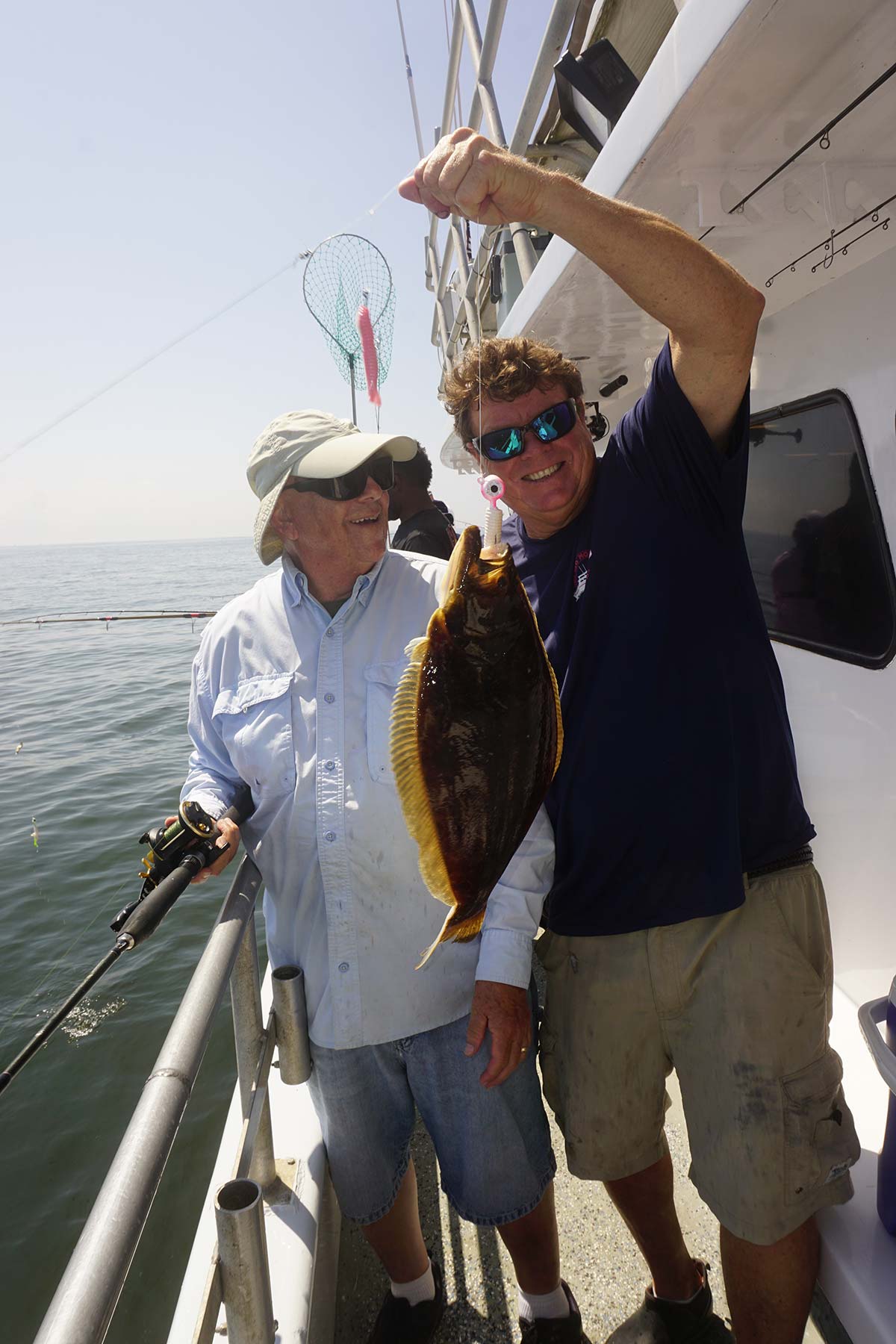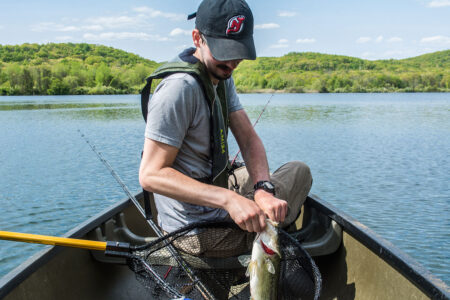
From Sea Girt to the Rattlesnake, it’s primetime on the northern sticky stuff.
The invisible line between North Jersey and South Jersey is a topic of longstanding debate. Some say the boundary is the Mullica River, where others see it more like the Manasquan. Fold a map of Sandy Hook to Cape May Point, and the middle is actually around Stafford Township.
From pork roll vs. Taylor Ham, to hoagie or sub, and on through professional sports team alliances out of Philly at New York, the differences between the north end of the state and the south are abundant. And fish and fisheries are no exception.
Fluke Or Flounder
In the Garden State, the earlier opening to the summer flounder season has been a boon for back bay anglers on skiffs, kayaks, tin boats and smaller center consoles. Coming in from the offshore grounds in early spring, these tasty flatfish filter into our estuaries sometime in April, which leaves them hungry in the very first days of May.
North of say Barnegat Light however, striped bass keeps northerners otherwise engaged in May. And while the upper stretches of Barnegat Bay, Shark River and the Navesink produce good fluke catches into June, warming waters typically drive those fish out into deeper waters heading into July. The big difference there in terms of Cape May County to the south opposed to Monmouth County to the north is just how far out is required to get to deeper water.
For comparison’s sake, Cape May Reef is roughly 8-1/2 miles from shore with depths ranging from 40 to 75 feet, whereas Sea Girt Reef off Monmouth County is just 3-1/2 miles out and boasts depths from 55 to 72 feet. On top of the deeper water is the natural structure that exists between Sandy Hook and Shark River, with a mixture of sandstone rock and boulders dating back 13,000 years to the last period of global warming when glaciers retreated to form the Hudson River; as a bonus, that great glacial shift left behind piles of rock at fluking hotspots like Takanasee and the Rattlesnake.
“The Hudson that pours out with all of those nutrients coming out at the end of the year, it puts that nice mix in there,” said Greg Hueth of the Big Mohawk IV out of Belmar. “I think a lot of it has to do with early in the spring when you get that nice runoff, that cold water underneath and it really sets up the bottom for the sand eels and everything else.”
Speaking from the wheelhouse of his family’s head boat, roughly a mile off the beach in 45 feet of water, Hueth explained the clash between cold and warm water that helps drive an ecosystem along this natural structure. “It’s just like what you’d find at the Great Barrier Reef where you get those nutrients that are born and all the fish feed off of that,” Hueth said, adding “this sea bass season there were plenty of sand eels around, and we caught plenty of sea bass on jigs right up until the final week.”
“You’ve got the Raritan Bay there, the edge of the Mud Hole and all the deep channels, I think these fish come off the edge of the hole and they filter in here,” added Big Mohawk skipper Payton Gepp. “There’s always food in here, there’s always bait on the edge of the hole so when they slide in they’ll just keep coming, getting into this structure where there’s plenty of food to eat,” Gepp added.
With that bait and all the craggy structure, there are incredible opportunities for snaring jumbo fluke, as well as the loss of fishing tackle; it’s a tradeoff between casual success by drifting and dreaming, and a personal best fish by way of constant attention and sacrifice.

Passing The Torch
Well before he took the helm of the Big Mohawk IV, and prior to joining the late Capt. Chris Hueth’s crew on deck of the 80-plus-foot Belmar-based head boat, Payton Gepp was a 17-year-old working at Matt’s Farm Market in Belmar.
“Chris called me a fruit flipper,” Gepp said, explaining how Hueth ultimately hired him away from his “fruit flipping” ways to climb aboard the Big Mohawk as a mate. “He said I need you tomorrow morning and every morning for the rest of the year,” he recalled. And I guess the rest as they say is history.
Chris and his twin-brother Greg grew up on the Belmar docks, cutting their teeth aboard the local head boat fleet. Professionally, Greg would take the Wall Street track, while Chris got his captain’s license and began co-captaining several local head boats like the Golden Eagle and Capt. Gary Fagan’s Big Mohawk III, the business Hueth would eventually own.
In late December of 2020 while ashore between blackfish trips, Capt. Chris Hueth suffered a fatal heart attack. He was just 59. As his obituary noted, “Chris gained legend status in the fishing industry as one of the hardest working captains on the coast.” On top of dealing with the sudden loss of a loved one, the Hueth family immediately had to figure out the future course of the family business.
“Payton grew up across the street from us, he’d come down to the lake and followed us around for years,” Greg told me from the wheelhouse of his family’s head boat, calling the 24-year-old “as passionate as you can get, and as good as you’re going to get.”
“Payton’s a lot like me and my brother, he likes to go fishing a lot,” Greg said of the young captain who first began fishing aboard the Big Mohawk when he was 10 years old. “Even on the days he’s not working on the boat he’s out fishing, so to him it’s more of a passion,” Greg added.
For those who’ve been around for a few years, the scene at local docks from Raritan Bayshore down to Cape May is not what it once was, as a once thriving Jersey Shore for-hire fleet has been greatly reduced; in my opinion, it’s primarily the result of ever-tightening fisheries restrictions. But there are a few ports in particular – notably Atlantic Highlands, Point Pleasant and here along the docks at Belmar and Neptune – where competition still thrives. That was evident on the day I hopped aboard the Big Mohawk for a day of working the sticky stuff outside of Shark River, as the bustling bulkhead at Belmar Marina was already alive at 5 a.m. with customers jumping aboard boats like the Golden Eagle, Ocean Explorer, the Royal Miss Belmar, Miss Belmar Princess and Parker Pete’s Express. August is prime time for many of these head boats targeting jumbo fluke which have set up on the nutrient rich boulder fields not far from the mouth of Shark River Inlet.

Mass Transit Fishing
Those who line the rails of a head boat – and I prefer “head” boat over “party” boat given the latter has been mostly appropriated by the urban “booze cruise” set – are typically like passengers on a bus or train. You might have your own vehicle, or can afford the relative luxury of a limo or Uber, but mass transit is the most economical way to travel from point A to point B. And much like my old days of commuting in and out of Manhattan, you’ll always find the regulars in their usual spots.
Setting up in the Big Mohawk’s stern with a conventional outfit and a pre-packaged fluke rig for the drift, mate Ron Tremblay grabbed the outfit from my hand and advised “go get your spinning outfit.” It was a windless morning with very little movement, which meant working a little harder to find the bite. Looking around at the Mohawk regulars beside me – Turkey Greg, Janet and Gerry Blinebury, as well as Joe, Dave, Eddy, Rich, George, Mark and rodbuilder John “Tailwater” Houghtailing – copying tactics is key to success along the rail.
Hueth handed me one of Tailwater John’s spinning rods with a Daiwa BG attached; an assortment of Tsunami ball jigs would get me through the day, tipped with 6-inch Gulp grubs in pink shine or white, as well as Fishbites Fight Club in white. Fishing from the stern in a slow drift, the key was casting back into the drift, reeling steady across the rocks (essentially against the tide) to elicit strikes or gain a follower or two. Often at the point where the drifting boat and location of the tipped bucktail met, the instant change in direction is met by a solid hit. “On days when the tide and wind are working a little better the conventional outfit will work a little better, but when you’ve got to cast around a little bit then it’s a little easier with spinning reel and that type of combo,” Hueth said.

In terms of the gear, both Hueth and Gepp advised a 7- to 8-foot medium or medium-light spinning rod rated for 1- to 3-ounce jigs, paired with a 3,500 series reel spooled up with 30-pound braid. “We fish 30-pound braid with a 25-pound top shot,” Capt. Gepp noted, adding that 8 to 10 feet of top shot can help you get back in the game more quickly when you break off in the sticky stuff. “That way you still come up with 8 feet of line so you can just tie a dropper loop and tie a jig on and get right back in the water,” Gepp said.
“Any of those PENN or Shimano reels rated for what Payton mentioned, they’re good, and most of our people have that onboard,” agreed Hueth. Bring plenty of multi-colored ball jigs and keep the dropper rigs simple; just your favorite 3/0 or 4/0 fluke hook, ideally with a bait keeper to keep baits in place, like Berkley’s Fusion19, and a bucket of multi-colored Gulps (thought truth be told, I got my hump busted pretty good for using anything but white or pink shine, even when my salmon red was getting banged up pretty good or when my 6-inch Fishbites Fight Club “white knuckle” grub lasted all day, fish after fish).
| SHARK RIVER FLEET |
| For-hire boats found each week providing regular fishing reports in The Fisherman report section, and how to contact them for a spot along the rail (passenger capacity in parenthesis).
Last Lady Fishing Charters 732-988-8907 (1-15) Smokin’ Reel Charters 732-245-8503 (1-6) Golden Eagle 732-681-6144 (up to 70) Victoria Marie 732-233-7967 (1-6) Skylarker 732-309-7689 (up to 49) Ol’ Salty II 800-836-TUNA (up to 55) Parker Pete’s 732-496-5028 (1-6) Parker Pete’s Express 732-496-5028 (up to 49) Miss Belmar Princes 732-681-6866 (up to 149) Royal Miss Belmar 732-681-0030 (up to 149) Just n’ Tyme Charters 609-286-8532 (1-6) Nearfall Fishing Charters 732-344-8833 (1-6) Big Mohawk 732-974-9606 (up to 50) |
Working these structure-laden grounds requires constant attention at the rod; dragging a ball jig or bucktail through this stuff will only lead you to retying more than calling for a net. That’s what makes head boat fishing out of Belmar or Neptune so nice, being that a crew of mates is there to assist and a captain (or two) is in the wheelhouse maintaining the right drift line along small, productive patches. “It’s tough when you have a weird drift like we do today because you can’t really control which way you’re going over it, and it’s harder to find,” Capt. Gepp said, adding “Especially this time of year when they’re in small patches, so if you can’t move and you can’t find them, it makes it a lot harder.”
The Shark River fleet, while competitive, works together in most instances, and the lineage is deeply shared. Prior to converting the old Freeport, NY based Starfish into the Big Mohawk IV, Capt. Chris Hueth worked on the Golden Eagle before hopping aboard Capt. Fagan’s old Mohawk. “Chris brought it down and that was it,” Greg said, recalling how Chris then bought the Big Mohawk business from Capt. Gary Fagan who had moved to Maine to run whale watching trips. “This is Gary’s machine right here,” Payton said from the wheelhouse, pointing to the old GPS unit hanging above the ship’s wheel.
“Chris went to work for Gary, and Gary sold him the business,” his brother Greg explained, adding “It’s, you know, potentially what we’re trying to do here with Payton.”
If you’re looking for August doormats, bring a cooler filled with ice to fit your catch and your cleaned fish, along with plenty of tackle; thankfully, you can leave the driving to someone else.




